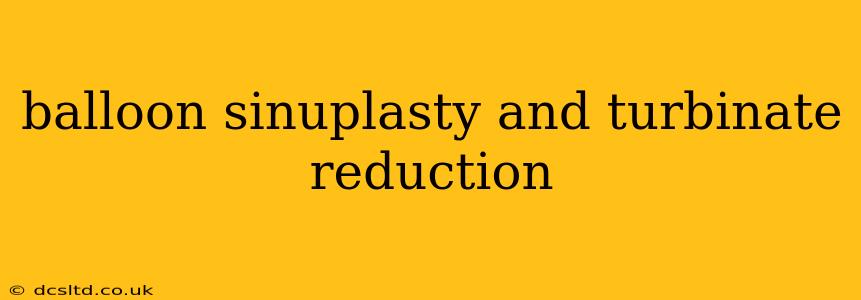Chronic sinus infections and nasal congestion can significantly impact your quality of life. If medications and other conservative treatments haven't provided relief, your doctor may recommend balloon sinuplasty and/or turbinate reduction. This comprehensive guide explores these procedures, addressing common questions and concerns.
What is Balloon Sinuplasty?
Balloon sinuplasty is a minimally invasive procedure used to treat chronic sinusitis. Unlike traditional surgery, it doesn't require the removal of bone or tissue. Instead, a small balloon catheter is inserted into the blocked sinus passage. The balloon is then inflated, widening the passage and restoring proper drainage. This helps alleviate sinus pressure, reduce inflammation, and improve airflow. The procedure is often performed under local anesthesia and typically involves a shorter recovery time compared to traditional sinus surgery.
What is Turbinate Reduction?
The turbinates are bony structures covered with mucous membranes located inside your nasal passages. They help filter and warm the air you breathe. However, enlarged or swollen turbinates can obstruct airflow, leading to nasal congestion and breathing difficulties. Turbinate reduction aims to decrease the size of the turbinates, improving nasal breathing. This can be accomplished through several methods, including surgical removal (partial or complete turbinectomy), radiofrequency ablation, or coblation. The choice of technique depends on the individual's anatomy and the severity of the turbinate enlargement.
What are the Benefits of Balloon Sinuplasty?
Balloon sinuplasty offers several advantages over traditional sinus surgery, including:
- Minimally invasive: Less tissue is removed or damaged.
- Shorter recovery time: Patients often experience quicker healing and return to normal activities sooner.
- Less pain and discomfort: Post-operative pain is usually minimal.
- Reduced risk of complications: The procedure carries a lower risk of complications compared to traditional surgery.
- Outpatient procedure: Generally performed on an outpatient basis, eliminating the need for an overnight hospital stay.
What are the Benefits of Turbinate Reduction?
The primary benefit of turbinate reduction is improved nasal breathing. This can lead to:
- Relief from nasal congestion: Improved airflow alleviates stuffiness and breathing difficulties.
- Better sleep: Uninterrupted breathing promotes more restful sleep.
- Improved sense of smell and taste: Better airflow can enhance your ability to smell and taste.
- Reduced snoring: In some cases, turbinate reduction can reduce snoring and sleep apnea symptoms.
Can Balloon Sinuplasty and Turbinate Reduction be Performed Together?
Yes, balloon sinuplasty and turbinate reduction are often performed together, especially if a patient suffers from both chronic sinusitis and nasal congestion due to enlarged turbinates. The combined procedure addresses both underlying issues, potentially providing more comprehensive and lasting relief.
What are the Risks and Complications of Balloon Sinuplasty and Turbinate Reduction?
While generally safe, both procedures carry potential risks and complications, including:
- Bleeding: Minor bleeding is common, but significant bleeding is rare.
- Infection: Infection is a potential risk with any surgical procedure.
- Pain and discomfort: While typically minimal, some pain and discomfort can occur.
- Numbness or altered sensation: Temporary or permanent numbness in the nose or surrounding areas is possible, particularly with turbinate reduction.
- Recurrence of symptoms: In some cases, symptoms may recur, requiring further treatment.
What is the Recovery Process Like?
Recovery times vary depending on the individual and the specific procedures performed. Balloon sinuplasty generally involves a shorter recovery period than traditional sinus surgery. Patients may experience some nasal congestion, mild pain, and swelling for a few days. Turbinate reduction recovery may take longer, with potential for more prolonged discomfort and swelling. Your doctor will provide specific post-operative instructions to ensure optimal healing.
How Long Do the Results Last?
The longevity of the results varies. Balloon sinuplasty often provides long-term relief, although some individuals may require repeat procedures. The effectiveness of turbinate reduction also varies depending on the technique used and the individual's anatomy. In some cases, turbinate regrowth can occur.
How Much Does Balloon Sinuplasty and Turbinate Reduction Cost?
The cost of these procedures varies depending on several factors, including the surgeon's fees, the facility where the procedure is performed, and insurance coverage. It's essential to discuss the costs and insurance coverage with your doctor and the healthcare facility before scheduling the procedure.
This information is for educational purposes only and does not constitute medical advice. Always consult with a qualified healthcare professional to determine if balloon sinuplasty and/or turbinate reduction are appropriate for your specific situation.
